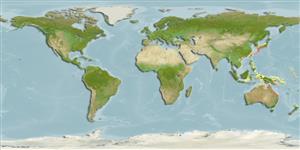>
Eupercaria/misc (Various families in series Eupercaria) >
Labridae (Wrasses) > Corinae
Etymology: Coris: Greek, kore, -es = pupil and also with themenaing of "maid" (Ref. 45335).
More on authors: Randall & Kuiter.
Environment: milieu / climate zone / depth range / distribution range
Ecología
marino asociado a arrecife; rango de profundidad 3 - 10 m (Ref. 33411). Temperate
Western Pacific: Viet Nam, Philippines and Australia.
Tamaño / Peso / Age
Maturity: Lm ? range ? - ? cm
Max length : 14.0 cm TL macho / no sexado; (Ref. 2334)
Espinas dorsales (total) : 9; Radios blandos dorsales (total) : 12; Espinas anales: 3; Radios blandos anales: 12. Females with longitudinal lines of orange yellow and light blue-green; a blue-edged black spot at the base of the caudal fin and a large blue-edged black spot basally in soft portion of the dorsal fin. Males exhibit the same patterns but have deeper blue-green to green lines, and with faint narrow green bars dorsally; a deep green spot is at the base of the pectoral fins; dorsal fins without the black spot present in females (Ref ). Body green dorsally with numerous longitudinal lines of orange-yellow and blue-green; blue edged black spot on upper caudal peduncle (Ref 9823).
A shallow-water species inhabiting rubble and sandy bottoms with algal cover (Ref. 2334). Often encountered in small groups (Ref. 33411).
Life cycle and mating behavior
Madurez | Reproducción | Puesta | Huevos | Fecundidad | Larva
Oviparous, with distinct pairing during breeding (Ref. 205).
Randall, J.E., 1999. Revision of the Indo-Pacific labrid fishes of the genus Coris, with descriptions of five new species. Indo-Pac. Fish. (29):74 p. (Ref. 33411)
IUCN Red List Status (Ref. 130435: Version 2024-1)
Threat to humans
Harmless
Human uses
Herramientas
Special reports
Download XML
Fuentes de Internet
Estimates based on models
Preferred temperature (Ref.
123201): 21.8 - 28, mean 26.5 °C (based on 744 cells).
Phylogenetic diversity index (Ref.
82804): PD
50 = 0.5000 [Uniqueness, from 0.5 = low to 2.0 = high].
Bayesian length-weight: a=0.00977 (0.00466 - 0.02049), b=3.07 (2.90 - 3.24), in cm total length, based on LWR estimates for this (Sub)family-body shape (Ref.
93245).
Nivel trófico (Ref.
69278): 3.4 ±0.3 se; based on size and trophs of closest relatives
Resiliencia (Ref.
120179): Alto, población duplicada en un tiempo mínimo inferior a 15 meses (Preliminary K or Fecundity.).
Fishing Vulnerability (Ref.
59153): Low vulnerability (10 of 100).
Nutrients (Ref.
124155): Calcium = 26.1 [8.2, 87.9] mg/100g; Iron = 0.26 [0.13, 0.59] mg/100g; Protein = 18.8 [15.9, 21.1] %; Omega3 = 0.351 [0.136, 0.879] g/100g; Selenium = 4.43 [1.30, 15.73] μg/100g; VitaminA = 102 [23, 540] μg/100g; Zinc = 1.24 [0.51, 2.42] mg/100g (wet weight);
